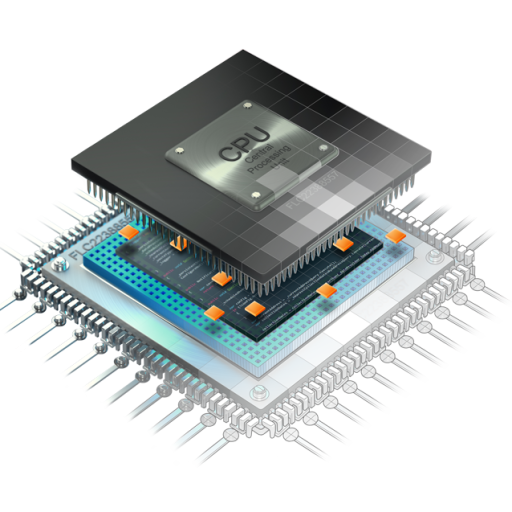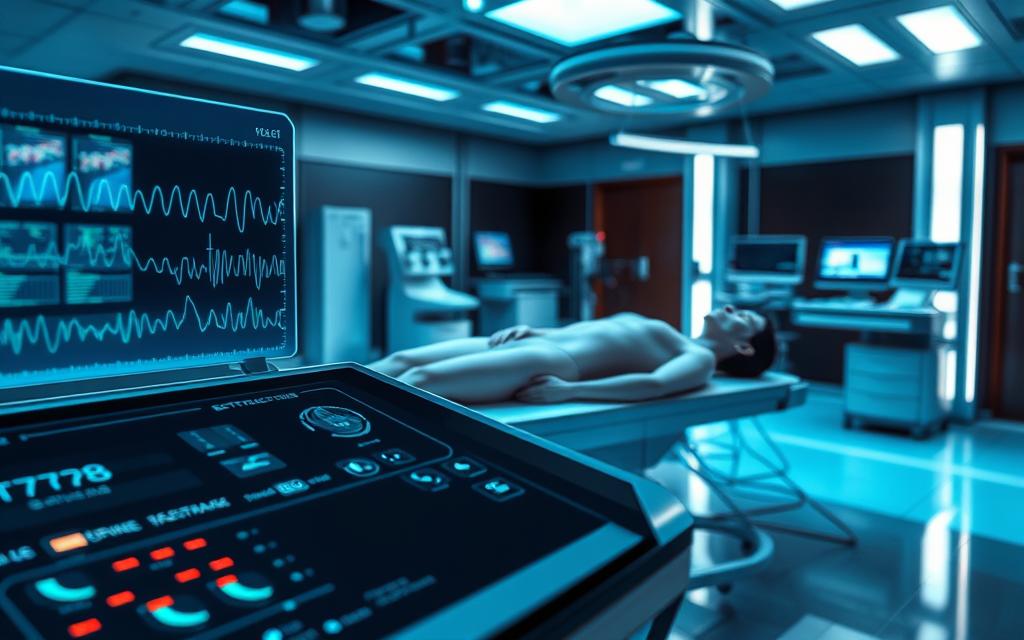Electronic muscle stimulation is a new way to help with health and fitness. It uses electrical signals to make muscles work through the skin.
Medical News Today says these signals are like the body’s own muscle activation. They make muscles contract on their own, helping to get them stronger and heal.
Doctors and athletes alike use this technology. It helps with getting better after injuries and boosts workout results.
Its wide use shows how valuable it is. It helps in many areas, from helping people recover to improving sports performance.
What is EMS Technology: Fundamental Concepts
Electronic Muscle Stimulation is a modern way to improve fitness. It uses electrical currents to make muscles work. This method sends controlled signals that make muscles contract, just like when we exercise.
Core Principles of Electronic Muscle Stimulation
EMS technology works by sending electrical signals to muscles. These signals make muscles contract, just like during exercise. It does this without needing the brain’s help.
Studies show that EMS mimics exercise by causing muscles to contract on their own. This means you can work your muscles without even trying.
EMS has key settings that make it work well:
- Frequency settings that control contraction speed
- Intensity levels that determine contraction strength
- Pulse duration that affects muscle fibre recruitment
- Programme variations for different training objectives
Key Components of EMS Systems
Modern EMS systems have important parts that work together. These parts make sure the stimulation is safe and effective. Knowing about these parts shows how advanced EMS technology is.
| Component | Function | Importance |
|---|---|---|
| Control Unit | Generates and regulates electrical impulses | Determines stimulation parameters and safety |
| Electrodes | Delivers impulses to muscle tissue | Ensures proper current distribution and contact |
| Power Source | Provides operational energy | Enables portable and consistent performance |
| Stimulation Programmes | Pre-set training protocols | Offers tailored workouts for different goals |
These parts work together to give a full EMS workout. The control unit manages the impulses, and the electrodes make sure the current reaches the muscles right.
EMS technology has gotten better over time. Now, it lets you control the stimulation exactly. This means you can get a workout that’s just right for you.
The Scientific Basis of EMS Functionality
Electronic Muscle Stimulation works by using precise science to activate muscles without needing to think about it. It does this by mimicking how our nerves naturally work, leading to specific muscle responses.
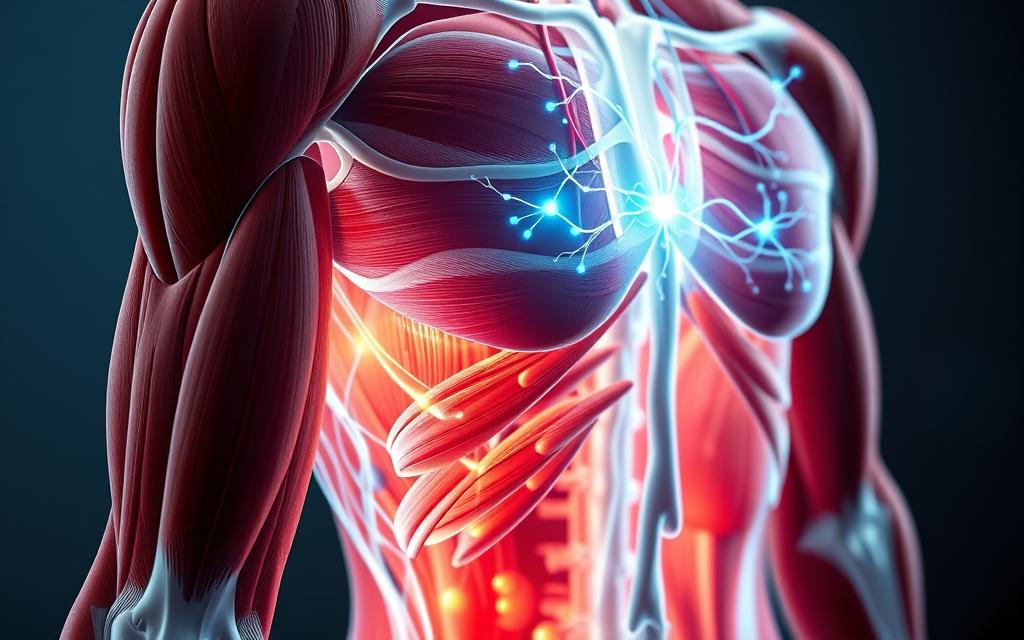
Electrical Impulse Transmission Mechanisms
EMS devices send out controlled electrical currents that go through the skin and into the muscles. These currents reach the motor neurons, which start the muscle activity.
The settings on the EMS device, like how strong the current is and how often it goes on and off, affect how deep it goes and which nerves it hits. Getting these settings right helps avoid any discomfort and ensures the muscles work well.
Muscle Fibre Recruitment Patterns
EMS is special because it can work on different types of muscle fibres at the same time. Unlike regular exercise, which usually focuses on one type, EMS works on both slow and fast fibres.
This way of working can wake up muscles that might not get used in regular workouts. EMS does this by:
- Working on many motor units at once
- Targeting specific fibre types
- Going deeper into the muscles than regular exercise
Studies show that EMS can get more muscle fibres working, which helps build strength and adapt muscles more efficiently.
Neuromuscular Response Characteristics
EMS does more than just make muscles contract. It also leads to changes in how the muscles and nerves work together, which helps in many ways.
These changes include better blood flow, more oxygen getting to the muscles, and faster metabolism. All these help the muscles recover and grow.
Over time, EMS also makes the connections between the brain and muscles stronger. This improves how well we move and coordinate our actions.
| Response Type | Primary Effect | Timeframe | Training Benefit |
|---|---|---|---|
| Acute Contraction | Immediate muscle activation | During stimulation | Muscle fibre recruitment |
| Metabolic Response | Increased blood flow | 0-60 minutes post | Recovery enhancement |
| Neural Adaptation | Pathway strengthening | 2-6 weeks | Movement efficiency |
| Structural Change | Muscle hypertrophy | 4-12 weeks | Strength development |
Scientific studies confirm that EMS works by mimicking natural muscle activation. This is why it’s used in sports, rehab, and fitness to help people achieve their goals.
Historical Evolution of EMS Technology
The story of electronic muscle stimulation goes back centuries. It started with ancient healing methods and has grown into today’s advanced wellness tech. This change shows our ongoing interest in how electricity affects our bodies.
Early Medical Origins and Development
Long before we knew how it worked, ancient people saw electricity’s healing power. In the first century AD, Roman doctors used electrical shocks from torpedo fish to ease pain. This was one of the first times electrotherapy was used.
In the 1700s, EMS history took a big leap forward. Luigi Galvani showed in 1761 that electricity can make muscles move. His work with frog legs was a key start to understanding how electricity affects muscles.
In the 1800s, doctors started using electrical stimulation for healing. Their early tools were simple but showed the basics of how to stimulate muscles. These early steps helped shape the technology we have today.
Modern Technological Advancements
The 1900s saw EMS technology grow fast. In the 1950s and 1960s, Soviet sports programs used it to boost athlete performance and speed up recovery. This was a big step in using EMS for sports.
As technology improved, rules for using EMS devices were set. The US FDA created guidelines to keep people safe and encourage new ideas. This helped make sure medical devices were different from everyday products.
Today, EMS tech has made huge strides. New electrodes and better programming make devices more effective. They are also easier to carry around.
Now, EMS technology brings together old wisdom and new ideas. It offers safe and effective ways to help muscles for health and fitness.
Contemporary EMS Device Categories
The world of electronic muscle stimulation technology has grown into different types. Knowing these types helps users pick the right EMS devices for their needs. It also makes sure they follow safety rules.
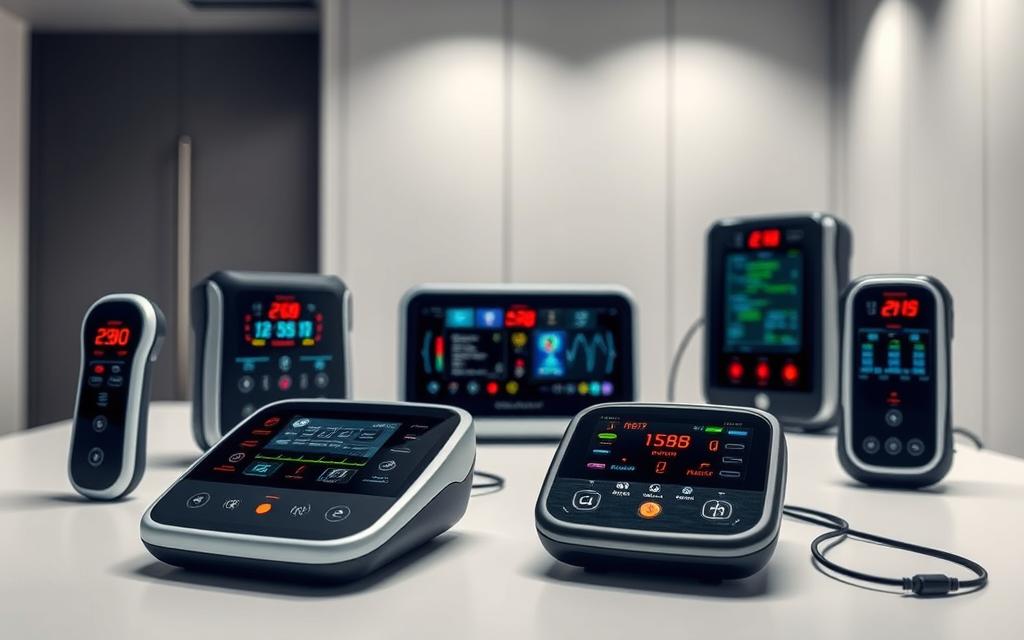
Professional Medical and Clinical Equipment
Medical-grade EMS devices are tested a lot and get FDA approval for certain uses. They have advanced settings and stronger outputs than home devices.
Rehabilitation and Physical Therapy Devices
Clinical units for rehab have precise control over how they work. Therapists use them to help muscles, manage pain, and help with brain injuries.
These devices have many features like different output channels and software to track progress. They need a pro to use them during treatments.
Advanced Athletic Training Systems
Top-notch athletic training devices are the latest in EMS tech. Athletes use them to boost power, speed up recovery, and avoid injuries.
These systems have wireless tech, can train groups, and have special programs for sports. They give strong stimulation to work muscles hard.
Consumer-Grade EMS Products
Over-the-counter EMS devices are for people to use at home. The FDA sees them as wellness products, not medical gear.
These products are easy to use and safe for people to use on their own. They don’t have as much power as the professional ones.
Home Fitness and Wellness Devices
Home fitness devices help tone muscles and improve overall fitness. They often connect to apps for workouts and tracking progress.
They focus on being easy to use and comfortable. Many come with pre-set programs for different muscle groups.
Portable Muscle Stimulation Units
Small stimulation devices are great for people who are always on the move. They are light, rechargeable, and easy to use.
These devices are all about being easy to carry without losing important safety features. They are a good starting point for trying EMS technology.
Comprehensive Benefits of EMS Technology
EMS technology does more than just contract muscles. It offers a wide range of benefits for physical health. It changes how we train, recover, and stay healthy. The EMS benefits are vast, from boosting performance to aiding in therapy.
Muscle Strength and Performance Enhancement
EMS technology boosts muscle strength by using electrical stimulation. It targets deeper muscle fibres that regular workouts miss. This leads to better strength and performance.
A scientific study shows EMS is safe and effective for fitness. It’s great for athletes, as it strengthens muscles without straining joints. It also allows for precise muscle group training.
Rehabilitation and Recovery Applications
EMS is a key tool in rehab, helping muscles recover and repair. It keeps muscles strong during rest periods after injuries. It also boosts blood flow to healing tissues.
Medical News Today says EMS can repair tissue and strengthen muscles. It helps heal faster and improves mobility. EMS programs help patients get back to normal quicker.
Time-Efficient Training Solutions
EMS training is quick, unlike traditional workouts. It activates muscles in shorter sessions. This is perfect for those with little time to exercise.
EMS sessions are as effective as longer workouts but take less time. It’s ideal for busy people and athletes. They can stay in shape with short, intense EMS workouts.
Additional Health and Wellness Advantages
EMS offers more than just muscle benefits. It improves local circulation, which is a big plus. This better blood flow helps deliver oxygen and remove waste.
Many people find EMS helps reduce pain. It can manage pain from different conditions. EMS also keeps muscles toned and encourages activity in those who find it hard to move.
The EMS benefits are wide-ranging. It’s useful for top athletes and those in rehab. EMS is a complete solution for today’s fitness needs.
Practical Implementation Scenarios
Electronic Muscle Stimulation technology has moved from theory to real-world use. It’s now a key tool in many areas. These EMS applications show how it helps in sports, health care, and fitness.
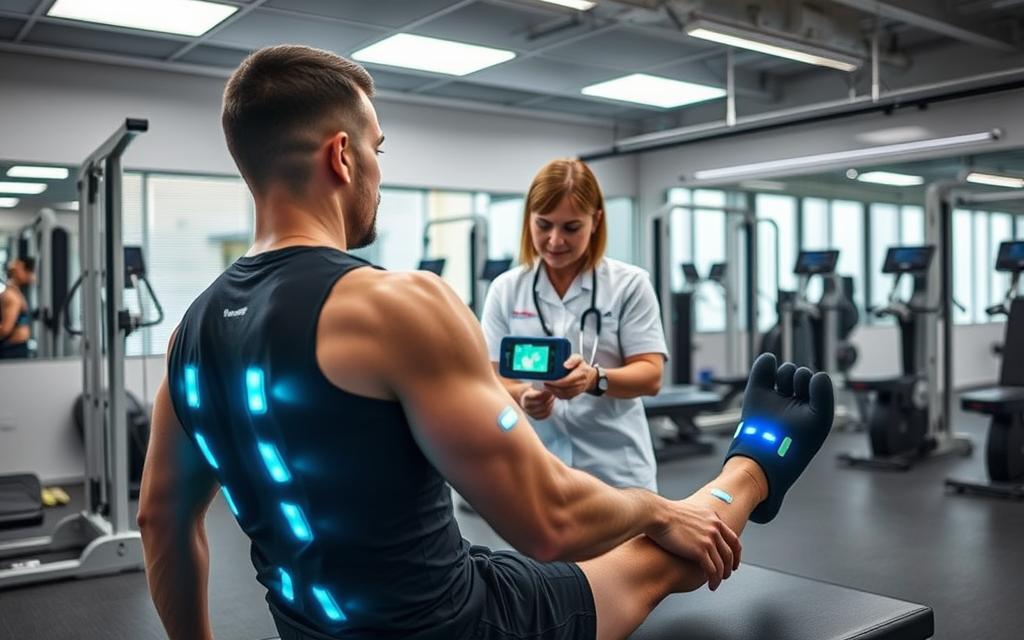
Athletic Performance Optimisation
Top athletes use Electronic Muscle Stimulation in their training. It’s a way to work out specific muscles without harming joints.
Elite athletes use EMS to speed up recovery after hard workouts. It cuts down muscle pain and boosts blood flow. Many say it boosts their performance when used with regular training.
Sports teams also use EMS for warming up before games and cooling down after. It keeps them at their best during tough seasons.
Clinical Rehabilitation Programmes
Medical places use Electronic Muscle Stimulation a lot in rehab. It’s really helpful for people recovering from surgery.
It’s also key in helping patients with movement problems. It helps fix damaged nerve paths and gets motor skills back.
It’s used to stop muscles from wasting away when people can’t move for a long time. Doctors set up these sessions to fit each patient’s needs.
General Fitness and Conditioning
Fitness fans are into EMS for getting in shape. Many add it to their usual workouts.
It’s great for those who don’t have a lot of time. A 20-minute EMS session can be as good as a longer workout. This makes it easier for people to stick to their fitness plans.
EMS is used for toning muscles and getting fit. People like it because it lets them focus on certain areas. It’s becoming more popular in the fitness world.
Safety Protocols and Usage Guidelines
Following safety guidelines is key when using EMS technology. It helps users enjoy its benefits while avoiding health risks. Knowing these rules is important because EMS affects our muscles and nerves.
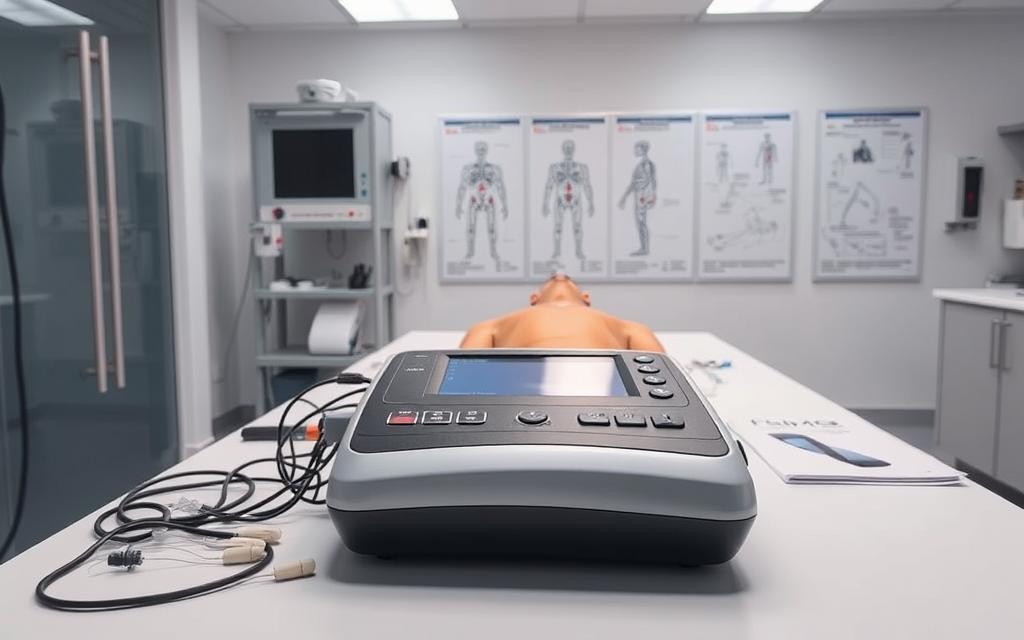
Medical Contraindications and Precautions
Some health issues mean you should not use EMS or be very careful. Medical News Today says people with certain health problems should not use these devices. The FDA has also warned about using EMS with certain groups of patients.
Here are some things you should not do:
- Pregnancy at any stage
- Presence of pacemakers or other implanted electronic devices
- Diagnosed epilepsy or seizure disorders
- Active cancer or recent cancer treatment
- Open wounds or skin conditions at electrode placement sites
People with heart problems, circulatory issues, or neurological disorders need to be careful. If you have metal implants near where you’ll be using EMS, talk to a doctor first. Always tell your doctor about your health before trying EMS therapy.
Optimal Usage Techniques and Practices
Using EMS correctly is important for safety and effectiveness. Where you place the electrodes is very important. This ensures you’re targeting the right muscles without affecting others.
Start with low intensity and gradually increase:
- Begin with lowest comfortable intensity levels
- Increase gradually until achieving strong muscle contractions
- Never exceed pain thresholds or tolerance levels
- Adjust based on individual sensitivity and response
Most treatments last 15-30 minutes. How often you use it depends on your goals. Most people do 2-3 sessions a week. Make sure to rest well between sessions, even more so if you’re also training normally.
Selecting Qualified Providers and Equipment
Choosing the right professionals and equipment is vital. For medical use, look for trained electrotherapy specialists. Physical therapists, athletic trainers, and rehabilitation specialists are often well-qualified.
When buying devices for home use, look for:
- FDA-cleared devices for the United States market
- CE-marked products for European standards
- Manufacturers with established safety records
- Devices with clear usage instructions and safety features
Good providers offer education with their products. Don’t buy from unknown sources. Getting professional advice is very helpful, even for the first time.
By following these EMS safety rules, users can safely use EMS in their routines. Knowing what to avoid, how to use it, and choosing the right equipment is key to using EMS well.
Conclusion
Electronic muscle stimulation is a big step forward in health and fitness. It boosts muscle strength, aids in recovery, and saves time. This makes it a great tool for many people.
It’s important to use EMS safely. Following the right steps and guidelines helps get the best results without risks. More studies will help make it even better.
EMS is set to get even better with new tech. It will soon be a key part of health and wellness plans. This will open up new ways to improve muscle and recovery.
Using EMS wisely can really help improve how we feel and perform. With the right knowledge and advice, its benefits can be fully enjoyed.
